Click here to return to Roman History and Civilisation menu
Click here for main Classics menu
If you have enjoyed reading these notes, please click here and visit the site of Paul Anbdrews' novel, "The Loner"
Roman Art and Religion
When Rome began its expansion, Greece already had an advanced civilisation. This was far superior than anything the Romans had. So they adopted Greek ideas, on religion, sculpture, science, literature, medicine etc. All
Roman drama and poetry, for example, had to follow Greek models - otherwise it wouldn't get published.
The Greeks believed in gods which represented the elemental forces of nature, but also took a human form.
The main gods included Jupiter (the sky god), Juno (his wife), Bacchus (the wine god), Mars (war), Venus (love),
Diana (hunting), Neptune (god of the sea and also responsible or earthquakes), Ceres (god of farming) Apollo
(god of light and prophecy), Minerva (goddess of the olive and wisdom) and Pluto (god of the dead and the
underworld).
There were others such as Mercury, the winged messenger of the Gods, Pan, the god of shepherds (usually shown as half man and half goat) and Vulcan, the god of fire, who made Jupiter's thunderbolts in his forge under Mount Etna.
There were also heroes such as Hercules, Theseus and Perseus, who were looked upon as demi-gods.
.
Neither Greeks nor Romans took their gods too seriously. They tended to laugh at them, and their legends are
not short of humour. So, for example, there is the story of Venus, who was married to Vulcan. Venus was
unfaithful and had an affair with Mars. When Vulcan found out, he caught them both red handed and gathered them both up in a fishing net, and then hung it up (with Venus and Mars inside) on Mount Olympus
for the other gods to laugh at.
As the Gods were thought to have a human form, their human form had to be perfect. So all Greek and Roman statues of gods show them in an idealised form. As the statues of the gods had to be perfect, they were frequently shown as naked. Some of these naked statues would have been dressed with new clothes at special
religious festivals.
However, wall paintings from Pompeii also show gods and heroes naked.
Infant mortality was always a problem in the Ancient World. If you survived into your teens, you had a very
good chance of living to a ripe old age - particularly in the Mediterranean. However, only a fraction of
children reached their teens. There was no pension system. So one way of ensuring you were cared for when
you were no longer able to work was to have children who could support you. So procreation and fertility rites were important. This may be another reason for the nudity of some of the statues of gods and goddesses.
That is how the gods and goddesses were shown in Roman art. Real people were treated differently. Statues of real people are nearly always sculpted fully clothed. They are less idealised and have genuine expressions on their faces which one can relate to. Roman emperors are usually shown in full military uniform - you will rarely
find a statue of a Roman emperor without his clothes!
Generally speaking, the Romans were not promiscuous. They were monogamous and most marriages were arranged. The gods were believed to live easily, and it was sin for mortals to copy their easy life or compete with them. So, if the gods were allowed to be promiscuous, mortals were not.
When Christianity triumphed in the fourth century and became the official religion of the Roman world,
Christians thought the statues of the old gods were obscene and profane, and systematically smashed as many as they could. That is why many Roman statues in museums are often without heads, legs or arms.
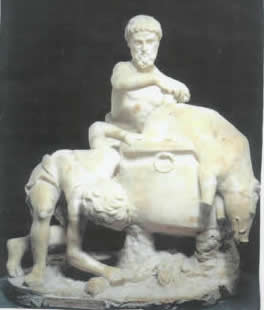
Man and boy organising a hog roast
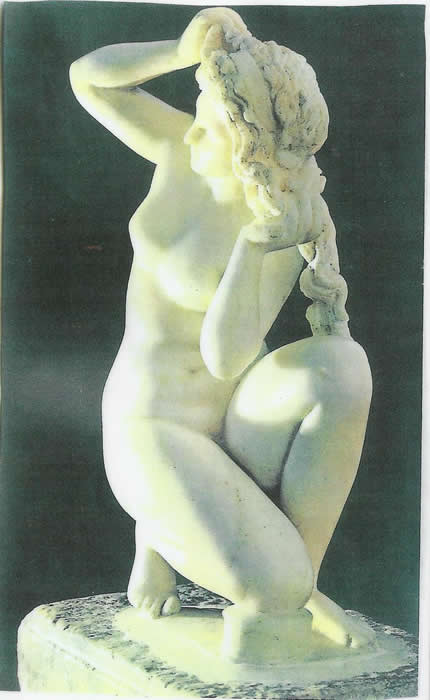
The goddess Venus comes out of the sea. Her Greek name was Aphrodite, which means the "the Goddess who rises from the surf"

Venus and the god Pan (with a cupid)
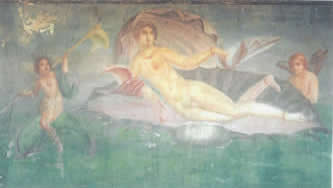
Venus on a shell - wall-painting from Pompeii

Initiation rites - wall painting from the House of the Mysteries at Pompeii
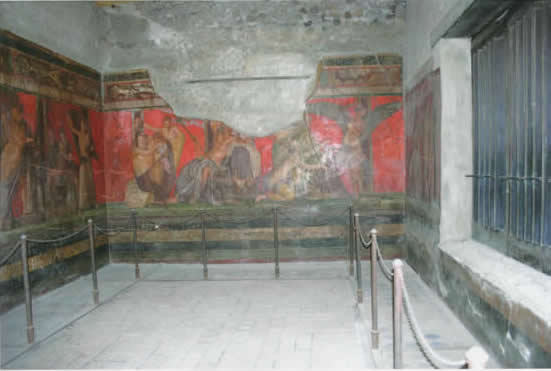
Initiation rites - as above
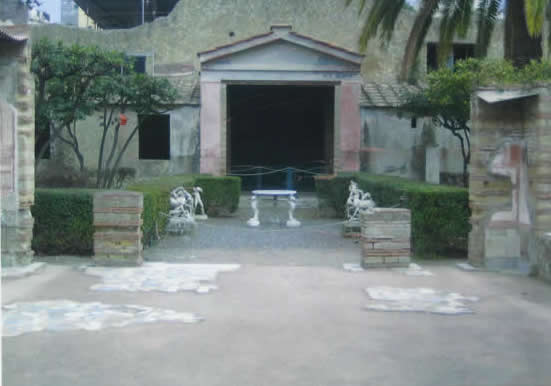
Garden of house at Herculaneum, showing garden sculptures

Cavalry battle scene: Alexander the great(left) leads the charge of his elite "companion" cavalry against the persian king Darius (right) - mosaic from Pompeii.

Inside one of the bath houses of Pompeii showing marine decoration on mosaic floor
Greek Legends
The Greeks had a rich and varied folklore which they included
in their literature and passed on to the Romans.
These stories were the subject of Greek and Roman art and literature. The paintings they produced were world class, but unfortunately they have nearly all perished. Luckily, they were reproduced all over the empire and copied as wall paintings and mosaics in houses and public buildings. Many of these copies have been preserved in Pompeii and Herculaneum.
Many of these legends became the subjects of plays and epic poetry. There is nothing boring about Roman and Greek literature!
Here are some examples of Greek legends.
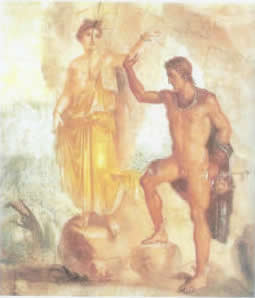
Wall paintinfg from Pompeii - Perseus and Andromeda. Perseus had to fight the Gorgon - a monster who turned anybody who looked at her into stone. Perseus had used his shield as a mirror, so that he could see the Gorgon without looking at her direct. In the picture, he carries her head in his left hand. He has just rexcued Andromeda, who he found chained to a rock as a sacrifice to a sea monster. Perseus killed the sea monster and rexcued Andromeda.
The Trojan War.
Paris, a prince of Troy, was asked by the god of Strife to award a golden apple "for the
fairest". Juno, Minerva and Venus claimed the apple. Juno offered him greatness; Minerva, success in war, and Venus, the loveliest woman for his wife. Paris gave the apple to Venus
and this made the other goddesses very jealous.
Venus then helped Paris carry off Helen, who was the wife of Menelaus, the king of Sparta.
This led to a ten year war between Greeks and Trojans. Many heroes died in the war, but the war was indecisive until the Greeks built a wooden horse and then pretended to sail
away. The Trojans thought the wooden horse was a religious symbol and pulled down part
of the city wall to bring it into the city. The horse had men inside it, and when darkness came they got out of the horse and let the Greek army into the city, which was then destroyed.
After the war, Odysseus sailed home, but was delayed for seven years in the island of the goddess Calypso. When he at last reached home, he found his palace had been taken over
by a large number of suitors who believed he was dead. His wife, Penelope, unlike Helen
loyal and faithful to the end, had put off making a decision as to which suitor to marry.
After a fight, Odysseus defeated the suitors and took back his kingdom and his wife.
Meanwhile, the Trojan prince Aeneas, whose mother was the goddess Venus, abandoned
Troy with his men, and wandered over the Mediterranean for many years until he came to
Italy. After a hard war with the local king they were allowed to settle there, and his descendants founded the City of Rome.
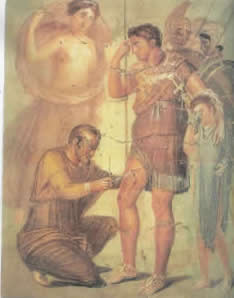
Wall painting from Pompeii showing the hero Aeneas being tended by a doctor after being wounded with an arrow. His son, Ascanius, is at his side.
Hercules
Jupiter fell in love with Alcmena. He disguised himself as Alcmena's husband and made the night three times as long as one night to ensure conception. Their son was Hercules.
Juno, Jupiter's wife, was very jealous. She sent a snake to kill
baby Hercules, but Hercules strangled it. Next she made him mad, and as a penalty for the crimes he committed when he was mad, Hercules was required to serve Eurystheus, King of
Tiryns for 12 years and perform whatever tasks the king set him.
One of the most famous of these is the cleansing of the
Augean Stables. Augeas, king of Ells, had enormous herds of cattle, and Hercules was required to cleanse in one day the dirt that had accumulated in their stables. This he did by
diverting the River Alpheus, so that it flowed through their yard.
We still use the expression "cleansing the Augean stables". It
is often applied to politicians involved in scandals such as the recent Expenses Scandal.
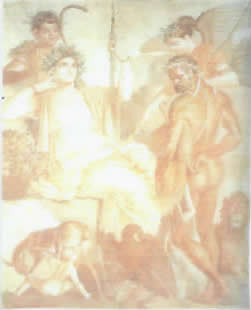
Wall-painting from Pompeii - Hercules and Telephus. Hercules seduced Auge, and Telephus was their son. Auge's father was angry and embarrassed. He sold Alge into slavery, and ordered the baby to be exposed. In this picture, Telephus is at the bottom left, being suckled by a deer, while Hercules (right) turns and discovers him. Arcadia, the goddess of the mountain is the lady at centre left. Telephus grew up to be a great hero in his own right.
TheMinotaur
Pasiphae, the wife of Minos king of Crete, had a passion for a fine bull which came out of the sea. Their offspring was the minotau - half bull and half man. This monster was put away in a maze in Minos' palace.
Minos demanded tribute from Athens: seven youths and seven maidens every year. He sent these into the maze and they were never seen again. Eventually Theseus, son of the king of Athens, offered to be one of the youths. The king was
very distressed to see his son go, but made him promise to put up a black sail on his return if he succeeded in killing the minotaur.
When Theseus arrived in Crete, he fell in love with Ariadne, King Minos' daughter. Ariadne gave him a ball of wool. When it was his turn to go into the maze, he unravelled the thread as he went, found and killed the minotaur and used the
thread to find the way back.
He and his companions then fled Crete, taking Ariadne with them. Then Theseus abandoned Ariadne on the island of Naxos. She lay weeping on the beech until the god Dionysus found her and consoled her with his love.
Meanwhile the king, Theseus' father, waited for the return of
his ships. Theseus forgot to change the sail, and the king seeing a white sail believed Theseus had been killed. He died of a broken heart before Theseus landed.
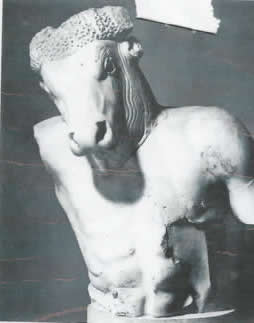
The Minotaur
Roman Drama
We only have about forty Roman plays. Most of these are comedies and were written by
Plautus and Terence in the mid second century BC.
This was a time when Rome was not yet mistress of the Mediterranean, when there were no
emperors and the Republic was flourishing and stable, and the people were free. It was also
a time when piracy was rife, and it was not unusual for pirates to take children and sell them
as slaves or prostitutes.
The plays had to follow Greek models and many are Roman versions of Greek originals, and they are all set in Greek cities and not in Rome. The characters have Greek names.
However, as the plays were written for a Roman audience, the society in which the
characters move is distinctly Roman - one the audience would understand.
The recurring themes are of lost children who grow up away from their families. Usually the children have been taken by pirates. Often there is a handsome young man who falls in love with a girl who is owned by a pimp and about to be put to work. Or the girl might have been
about to be given away to marry a much older man who she does not fancy. The young man is
not all that bright, but has a clever slave, who sorts things out, after many adventures and
comic mishaps. The ending is usually a happy one, with the lovers united and the slave,
freed in gratitude for his help.
The plays are full of scenes where parents recognise their grown up children after they have
disappeared for many years.
Terence was himself a freed slave, and both he and Plautus show a remarkable sympathy
for the underdog.
The plays vary in tone, some of them being more romances than comedies and others being
outright farces. The "Braggart Soldier" is a brilliant example, and one of Plautus' best loved plays. Three of Plautus' plays are combined in the musical "A Funny thing happened on the Way to the Forum" - by Stephen Sondheim. The musical keeps the flavour and the atmosphere of the originals.
The actors wore masks during performances. At first this was because the theatre had evolved out of religious ceremonies, and the mask was a traditional part of these. However, the tradition was never abandoned. The theatres accommodated thousands. It was possible to build them in a way which allowed sound to travel to the back rows, but clearly the view from the back would not have been so good. So masks would have helped the audience to identify the characters.
The plays are just as effective today when performed without the masks. Men or boys played the female parts, but they are probably
much better presented today with real actresses.
Both Plautus and Terence influenced Shakespeare, and his "Comedy of Errors" is based on Plautus' "The Brothers Menaechmus".
These plays show the Romans in a completely different light to the one we are used to. We think of the Romans as great soldiers and engineers. The abiding impression one gets from
the plays is of fun loving Italians, and perhaps after all the military bravado, that is what
they were really like.
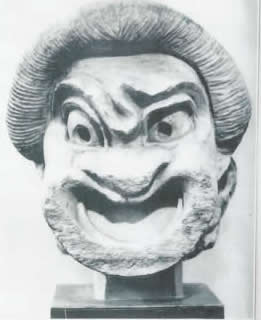
Comic mask
Roman Tragic Theatre
The other surviving plays are the ten tragedies written by Seneca. With one exception these are all about Greek legends, and are modelled on Greek plays written five
hundred years earlier.
Seneca was the emperor Nero's prime minister during the
early part of that emperor's reign (54AD - 62AD). Nero
became emperor at the age of 16, and Seneca governed the empire for many years. Two years after his retirement, Nero
accused him of plotting against him and ordered him to commit suicide. So, in a way, Seneca was himself a tragic figure.
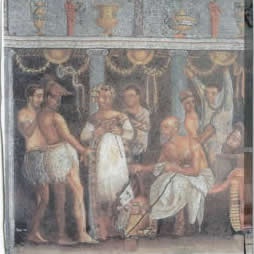
Mosaic showing actors in thier dressing room, Note the mask on the right hand side
King Oedipus - a Greek (and Roman) tragedy we've all heard about.
This is one of Seneca's plays. It is modelled on the original Greek play by Sophocles.
It's a cautionary tale which enraged motorists on single track roads or bridges would do well to take notice of!
Oedipus was the son of Laius, the king of Thebes, and his wife Jocasta.
There was a prophecy that Laius' son would kill his father and marry his mother. So Laius ordered his baby son to be taken away and made to die of exposure on Mount Cithaeron. A shepherd was ordered to do this, but could not leave the baby to die. So he gave the baby to another shepherd, and eventually Oedipus grew up in the court of the neighbouring king of Corinth, believing he was his son.
When much older, Oedipus received a prophecy: that he would kill his father and marry his
mother. He therefore left Corinth so that he could never kill the man who he believed was his father.
On his journey, he came to a narrow place with cross roads and encountered an older man with
servants. The older man ordered him to give way, but Oedipus was too proud to do so. As neither
would give way to the other, there was a fight and Oedipus killed the older man and all his servants
except one - and this was in the days before motor cars!
Oedipus then continued on his journey to Thebes. There he found a sphinx, a monster with the body of a lion, the wings of a bird and the face of a girl. The sphinx sat on a hill and chanted a riddle:"What is the creature which is two footed, three footed and four footed; and weakest when it has most feet?" Every failure to find an answer cost the Thebans a life. Oedipus offered the answer:"man". The sphinx acknowledged this was the right answer and flew away.
Meanwhile it had become known that the king, Laius, had been killed. The people of Thebes were so pleased to see the Sphinx go that they offered to make Oedipus king. For this to happen he had to marry the dead king's wife, Jocasta.
All this happens before the action in the play.
The play starts many years later, when Oedipus and Jocasta have been living together happily and have two young daughters. There is a famine and a plague and Oedipus asks the Oracle of the God Apollo at Delphi what should
be done to relieve the city of the plague. The oracle replied that the city must first purge itself of its
pollution - namely the murderer of Laius.
Oedipus starts a public investigation, and slowly the facts begin to emerge. It turns out that the shepherd who took Oedipus as a baby to Mount Cithaeron was the same servant who was the only one to escape when Oedipus had killed the older man and his retinue at the cross roads.
As the facts become clear with mounting horror, Oedipus is distraught. Jocasta hangs herself and Oedipus puts out his eyes, using the pin of Jocasta's broach.
So, if you are a motorist on a narrow road or bridge where there is only room for one vehicle, don't
argue, just pull over and the let the other car pass!!
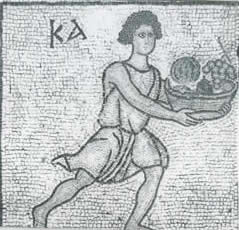
Greek and Roman Philosophy - who invented the atomic theory?
Greek and Roman philosophy included science and ethics. The first philosophers were more interested in how the world began and what it is made of than in how we should behave.
Socrates challenged the thinkers of his time to define such concepts as “good” and “virtue”.
Plato thought the world was set in motion by a “self-moved” prime-mover, and this is how creation began. This prime-mover would have had form but not substance. The purpose of philosophy was therefore a life of contemplation in which one might discover “goodness” or “virtue” etc. as forms which are perfect but independent of substance.
Aristotle was more practical. He thought everything was made of a mixture of certain primary elements, namely earth, air, fire and water. Aristotle agrees with Plato that the ideal is a life of contemplation, but says this is beyond the reach of ordinary people. One needs to take a practical view of morality based on choice by practical wisdom. He thought virtuous behaviour was a golden mean between opposite extremes. So, for example, “courage” as a virtue is a mean between foolishness and cowardice – so that virtue might be described as a mean between ascetism and the yielding to uncontrolled impulses.
By the time of the emperors, the two main schools of philosophy for both Romans and Greeks were the Stoics and the Epicureans.
The Epicureans thought that the world came into being from particles which could not be split, called “atoms” (meaning “uncuttable”). These were constantly falling through a void, and when they swerved, they coalesced. There was therefore no creating “unmoved mover”, as in Plato, and, as the universe had been created by a chance coalescence of atoms, the gods (if they existed) could have no power to influence it. Without divine guidance on morality, the primary moral motivations could only be pleasure and pain. All pleasures were therefore good. However, this was not a purely hedonistic philosophy, because it was recognised that some pleasures can lead to pain, and other pleasures cannot be achieved except after considerable pain. So, for example, the pleasures of peace may sometimes only be achievable after the pains of war. So one has to make a calculation and it may be necessary to choose pain rather than pleasure, depending on the circumstances.
The Stoics, on the other hand, regarded the world as an organic whole animated and directed by intelligence and consisting of an active principle (ie. God) and that which is acted upon (ie. Matter”). These were two inseparable aspects of reality. In these circumstances, one had to live one’s life in harmony with nature, this being a life of virtue, for virtue is the law of the universe, God’s will. This led to a belief in the universal brotherhood of man, without distinction between Roman and barbarian or freedman and slave. Stoic virtue comes very close to what we call enduring hardship and adversity with a “stiff upper lip”
Most educated Romans tended to adopt the Stoic view, and this fitted neatly into the Christian religion, as this began to spread throughout the empire
Roman Law
Very early in the Republic, the “Twelve Tables” were published. This was a law code which was only appropriate to a small primitive city state.
The administration of the law was entrusted to magistrates who were elected annually, the Praetors. These would publish an edict listing the actions which they were prepared to deal with, and the circumstances and rules which would apply. As time passed, successive praetors adopted the edicts of their predecessors and added to them, and a body of law evolved.
Later, particularly during the time of the emperors, some eminent lawyers were asked to give opinions on legal issues. These were written down and regarded as good authority when resolving legal actions. The most eminent of these “jurists” were Ulpian and Pappinian.
The Romans believed that the law should be a body of rules which should apply naturally in any civilised society, and so Roman Law developed a strong international flavour which ensured its survival
Almost a century after the collapse of the Roman empire in the West, the East Roman Emperor Justinian codified the law in Latin. However, Roman law fell out of use in the West following the barbarian invasions and the feudal society which evolved from these.
Justinian’s code was rediscovered in the Renaissance. It was recognised as being far superior to the laws in force at the time, and was studied carefully by scholars. Eventually, Napoleon decided to adapt Justinian’s Code for France, and published the “Code Napoleon”. This was adapted by other European countries, and Germany published its own code, which was also based on Roman law. Roman law was then exported to the colonies of these countries, and Japan adopted the German code.
The only European country which did not adopt Roman law was England, which had developed its own system, which worked just as well. Even so, Scottish law is based on Roman law, and Roman law could be quoted as authority in an English court, if there was no English legal precedent.
English Law followed the flag, and the law of the USA and other former British colonies is based on it.
There are therefore two main legal systems in the world today: Roman law, and the English “Common Law”, which itself has been strongly influenced by Roman law.
Children's Stories
The Romans valued family life.
In the 6th Century BC the greek story teller Aesop had told many children's stories. These were eventually written down and later translated from Greek into Latin
Over the centuries, many stories were added which Aesoop had not written.
Roman children read these stories, just as our children read them today. Here are a few:
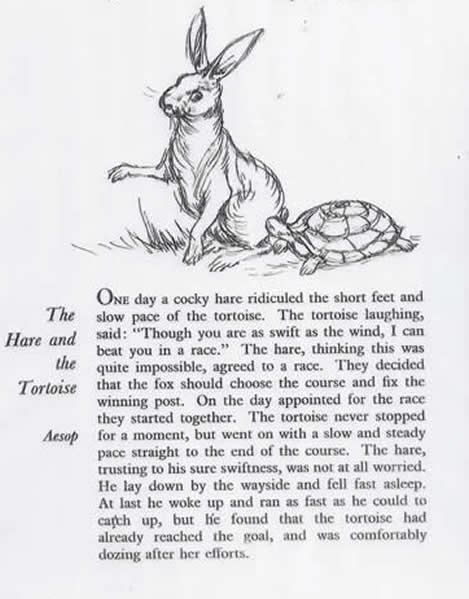
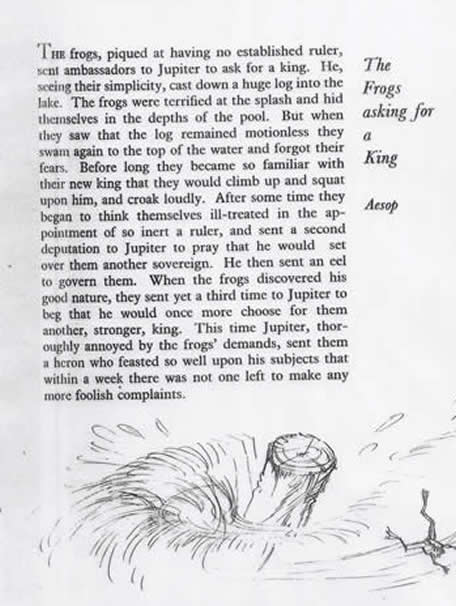


Our Heritage from Ancient Rome
Greek culture and ideas were taken over and developed by the Greek empires of Alexander the Great and his successors, and later by the Roman Republic and the Roman Empire.
So Roman civilisation was never entirely Roman or Italian. The best way to describe it is"Romano-Greek" or "Classical".
The official date of the end of Classical culture is about 529AD when the Eastern Roman
Emperor Justinian closed the Greek schools of philosophy in Athens, as he thought anything to do with pagan culture was automatically anti-christian.
This would have had the same impact then as the closing of Oxford and Cambridge universities would have on modern society.
Classical culture revived after the fall of Constantinople to the Turks in 1453. That is when universities in Europe, such as Oxford and Cambridge, started to take a new interest in the Greek and Roman Classics. It's called the "Renaissance" period - the rebirth of learning. Greek and Roman ideas of art, literature,
Romano-greek law,science, medicine, philosophy, drama, architecture, military organisation and government were adopted and used to "modernise" Mediaeval Europe, and have been part of our
heritage ever since.
To take a simple example of Classical influence on the modern world, doctors today are
required to observe the "Hippocratic Oath" - the oath which was set by the Greek doctor
Hippocrates and which prohibits euthanasia.
Half the modern world's legal systems originate from Justinian's law code. So one might say half the world obeys Roman Law.
We no longer worship the Greek and Roman gods, but ancient mythology has found its way into English poetry and drama, for example in Shakespeare's plays, and one might say that the Greek gods are still the gods of our poetry.
Greek civilisation was inspired by the democracy of ancient Athens. Before the final military
takeover of the Roman Empire by Octavian in 29 BC,there was a sustained campaign to save
the Roman Republic, and much of the literature from that period survives.
The European Upper Classesof the 15th- 18th centuries loved the Classics- so long as their study didn't undermine their own position. It took a very long time before they came to accept that the democratic ideals of Classical Athens and Republican Rome might be a good thing for everybody after all!
The Romans were a very practical people. Their contribution to modern life is something we
take for granted, often without realising where it all came from. For example, they founded
the cities we still live in; they built roads we still use; their calendar is still in use today, as are their laws, and
they invented the Roman alphabet which is our alphabet and is so versatile and adaptable that it is used all over the world for all kinds of languages, and is so well suited for computers - the ultimate modern use.
$0 what we now know as "Western" civilisation has its roots in the Roman period. One
might even argue that, in a sense, the Romans have been back with us for at least five
hundred years!
Click here to return to Roman History and Civilisation menu
Click here for main Classics menu
If you have enjoyed reading these notes, please click here and visit the site of Paul Anbdrews' novel, "The Loner"
|



